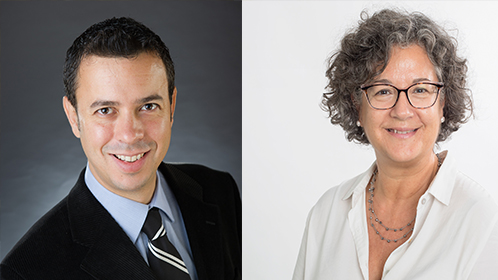News
Identifying High-Risk Factors of Pancreatic Cancer
Dr. Raul Rabadan is leading a global research project as part of a new grant from the Pancreatic Cancer Collective to identify high-risk factors of pancreatic cancer. (Courtesy of Stand Up to Cancer)
A global team of researchers led by theoretical physicist Raul Rabadan, PhD, professor of systems biology at Columbia’s Vagelos School of Physicians and Surgeons, and Núria Malats, MD, PhD, head of the Genetic and Molecular Epidemiology Group of the Spanish National Cancer Research Centre (CNIO), are working to develop a comprehensive computational framework that will identify high-risk factors for pancreatic cancer.
Armed with a new two-year, $1 million grant from the Pancreatic Cancer Collective, the team intends to attack pancreatic cancer research from multiple disciplines—genomics, mathematics and medicine—to provide an integrated, computational approach to studying genomic, environmental and immune factors that could identify populations at high risk of pancreatic cancer. The need for deeper understanding of the contributing factors to this lethal disease is pressing, as pancreatic cancer is projected to become the second leading cause of cancer-related mortality within the next decade.

Drs. Raul Rabadan and Nuria Malats
Pancreatic cancer currently has the lowest overall survival rate across all major cancers. The majority of pancreatic cancer patients overall live 8 to 12 months after diagnosis, and the instances of the disease are on the rise. While some key risk factors have been identified—age, non-genetic factors such as obesity, type-2 diabetes mellitus, and smoking, among others, and a handful of genetic mutations—currently known factors only explain a small fraction of the attributable risk of pancreatic cancer. Early detection remains a major challenge. By the time most patients are diagnosed, their prognosis is bleak.
Drs. Rabadan and Malats will co-lead the project with Ken Olive , PhD, assistant professor and core director at the Herbert Irving Comprehensive Cancer Center (HICCC) at NewYork-Presbyterian / Columbia University Irving Medical Center ; Tal Korem , PhD, assistant professor of systems biology and core member of Columbia’s Program for Mathematical Genomics (PMG) ; Gulam Manji , MD, assistant professor of medicine and faculty member of the HICCC; Ioan Filip , postdoctoral fellow of systems biology; and Esther Molina, Miguel Servet staff scientist in Dr. Malats’ Group.
“Our interdisciplinary team of researchers—from molecular epidemiologists and clinicians to experts in tumor genomics and the microbiome—will work together to tackle this problem,” says Dr. Rabadan. “We will explore large-scale datasets from the U.S. and Europe to build this new computational framework, and also study preliminary epidemiological and genetic observations that link pancreatic cancer risk to the immune system. Our goal is to create a reliable, integrated framework for identifying populations high-risk for this detrimental disease.”
The researchers will focus on rare gene variants, specific DNA regions and modifications, within large clinical and molecular datasets from multiple published databanks. The datasets include the UK Biobank, European Study on Digestive Illnesses and Genetics (PanGenEU), The Cancer Genome Atlas and the International Cancer Genome Consortium. The team also plans to characterize the tumor microenvironment, specifically the microbiome and expression of proteins important for immune system regulation.
Attempting to understand the cancer biology of pancreatic tumors is arguably a far more difficult undertaking than most cancer tumors, notes Dr. Olive, an expert in pancreatic cancer research and director of the Oncology Precision Therapeutics Imaging Core at the Cancer Center, and this is in large part due to the tumor’s unique structure.
“In pancreatic cancer, some cells within the mass of a tumor that are not mutated—the stroma cells—which are part of your normal body, have been recruited to help drive tumor growth,” says Dr. Olive, and this makes studying tissue samples challenging.
“These stroma cells far outnumber mutant tumor cells, and they make it very difficult to study the tumor biology,” he adds “We’ve been focusing on how to tease out the biology.”
As part of this new project, researchers will also use a unique dataset from the Olive lab derived from manually carving out non-malignant cells from tumor cells in tissue samples, separating the different cell types and analyzing each component. This, and other complex data sets—clinical outcomes data and microbiome data—will help in expanding the team’s integrated computational platform to identify high-risk factors for the disease.
The American Cancer Society estimates for 2019 that about 56,770 people will be diagnosed with pancreatic cancer, and about 45,750 people will die from the disease. Pancreatic cancer is slightly more common in men than in women, and to date, the most common forms of treatment are surgery, chemotherapy and radiation.
“Pancreatic cancer has become one of the most deadly cancers,” notes Dr. Rabadan. “Identifying genetic and epidemiological markers can elucidate risk factors that could lead to early detection. Our aim is that this project can greatly improve our ability to screen and identify highly susceptible individuals of this lethal disease.”
Drs. Rabadan and Malats’ co-led project was announced March 30 by the Pancreatic Cancer Collective, a partnership of Lustgarten Foundation and Stand Up To Cancer (SU2C) , at the annual meeting of the American Association for Cancer Research . Dr. Rabadan’s expertise lies in the cross section of mathematical genomics, tumor evolution and cancer research. In the spring of 2018, SU2C awarded him the Philip A. Sharp Innovation in Collaboration award. At Columbia, Dr. Rabadan also is a professor of biomedical informatics, a faculty member of the HICCC and the founding director of the Program for Mathematical Genomics.
-Melanie A. Farmer